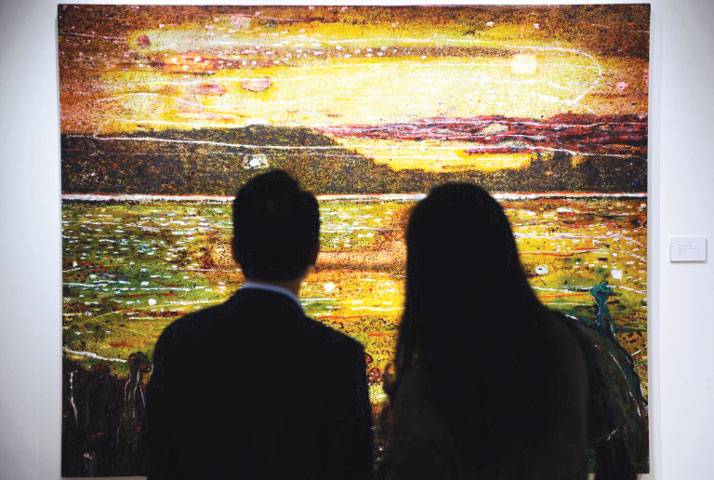Laziz the tiger and friends leave Gaza for new life
EREZ, (AFP): Palestinian TerritoriesGaza’s last tiger left the war-ravaged Palestinian enclave Wednesday with monkeys, emus, a porcupine and other animals from a zoo dubbed the “world’s worst”, heading for a new life in South Africa and elsewhere. Laziz (Cutey in Arabic) the tiger and the 15 other remaining animals from the Khan Yunis zoo were driven on a trailer in cages to the Erez crossing before dawn, an AFP journalist said. The animals crossed the border en route to sanctuaries and zoos in South Africa, Jordan and Israel for “a better quality of life”, the Israeli army said in a statement. As well as Laziz, five monkeys, two emus, two deer, two eagles, two turtles, a pelican and a porcupine were transferred, the Four Paws charity ensuring the animals’ welfare said. For months vets from Four Paws had been visiting the zoo in southern Gaza to treat the animals and transfer them out after international outcry at photos of their conditions.
Dozens of animals had died in the zoo, some of starvation, and badly stuffed bodies of dead crocodiles, lions and others were left in the open, surrounded by piles of bones.
The NGO says on its website that Khan Yunis had “been known as the ‘worst zoo in the world’ since it became public last year that the zoo was crudely mummifying the animals that died in their care and displaying them.”
Wednesday’s transfer leaves the zoo empty and it will now be closed.
“So many people have followed the progress of our mission eagerly and shown their solidarity with Laziz and the other animals,” Four Paws vet Amir Khalil said in a statement.
“We are happy that we were finally able to close down Khan Yunis zoo.”
Laziz’s case attracted particular attention, after it was revealed the near-starving tiger had originally been brought to Gaza from Senegal via Egypt, where he was smuggled through tunnels into the enclave.
He will now be transferred to the Lionsrock refuge for big cats in South Africa.
“We were quite worried if Laziz would go into his transport crate without any issues,” Khalil said.
“But the tiger just went straight into the box as if he knew that we will bring him to a nice home.”
In the years after its 2007 opening there were more than 100 animals housed at the zoo, but they were decimated by repeated wars and shortages of customers.
The owners were unable to afford enough food, with some animals starving.
“I am very sad,” lamented owner Ziad Aweda. “I brought these animals from Libya, Sudan, Egypt and even South Africa to Gaza.”
The nearly two million residents of Gaza are also suffering and find it difficult to get permits to travel to Israel, which has maintained a blockade on the enclave for a decade.
More than two-thirds of Gazans are reliant on some form of aid, according to the United Nations.
Hamas, which runs Gaza, has fought three wars with Israel since 2008, the most recent in 2014 in which 2,251 Palestinians died, the majority civilians, according to the United Nations.
Seventy-three Israelis, including 67 soldiers, were also killed.
The Israeli blockade of the enclave and Egypt’s closed border have suffocated the economy, making it increasingly hard for Gazans to find money for leisure.
Taiwan police grapple for control of Pokemon swarms
TAIPE (AFP): Police are struggling to control crowds at a hot springs park in Taiwan that has become a hub for Pokemon Go players after gaining a reputation as a spot to catch rare creatures. The normally quiet park in Beitou, just outside the capital Taipei, has been thronged in recent days by enthusiasts of the wildly popular mobile gaming app. Pokemon Go has sparked a global frenzy since its launch last month as users hunt for virtual cartoon characters overlaid on real-world locations using augmented reality technology. Police are now having to divert traffic around the Beitou park and bring in additional manpower to control the crowds, they said this week. An unverified video that appeared to show thousands of people rushing across a traffic intersection in Beitou, apparently chasing after a Pokemon, went viral this week.
Police say they have now downloaded the app Go Radar - which players use to locate Pokemons - to predict where the crowds will gather.
On Tuesday night, hundreds of people of all ages swarmed through the park, an AFP photographer said.
The crowd rushed in one direction when someone cried “Dragonite! Dragonite!” - the name of a Pokemon considered hard to catch.
Others were playing the game while riding their scooters.
A total of 474 traffic fines have been doled out around the Beitou park over the last two weeks.
Earlier this month, police said more than 1,200 drivers around the island had been caught for violating traffic rules by playing the game while at the wheel, within days of Pokemon Go’s launch in Taiwan.
But while authorities may be struggling, some local businesses in Beitou - famed for its hot springs - are tapping in to the trend, with hotels offering discounts to players and eateries drawing long queues.
US judge sides with artist forced to prove painting is not his
CHICAGO (AFP): In a court case with repercussions for the art world and millions of dollars at stake, a US judge ruled Tuesday in favor of an artist who was sued for denying a painting was his. A US District Court judge in Chicago decided that Peter Doig, a world-famous artist who insists he did not create a desert landscape painting, is telling the truth. The man who owns the disputed piece of art, a retired Canadian corrections officer by the name of Robert Fletcher, sued Doig for refusing to acknowledge that the painting is one of his works - which means its value is significantly diminished. Judge Gary Feinerman ruled that there was “conclusive” evidence that Doig did not paint the disputed work, and that he had the right to say a painting was not his.
The facts surrounding the case date back to Canada in the 1970s, when Fletcher met a man named Peter Doige - spelled with an e - and watched him study art while jailed for a drug offense.
Fletcher says he remembers being impressed by one of Doige’s paintings of a desert landscape in golden hues - an acrylic painting on linen. He bought it for $100 in the hopes of keeping Doige from going back to selling drugs.
Decades later, a friend saw the painting hanging in Fletcher’s home and said it was in fact the work of Peter Doig, whose creations can command $10 million at auction.
Fletcher spoke with Chicago-based art dealer Peter Bartlow, who agreed to sell the work.
But Doig denied every element of Fletcher’s story - painting the work, meeting Fletcher or being incarcerated in Canada.
Doig’s lawyers pointed to a Canadian man named Peter Doige, who was a carpenter and amateur painter. He died in 2012 but his life story seemed to closely match the circumstances surrounding the painting’s creation.
Feinerman concluded that “an artist is well within his rights to ensure that works that he did not create are not sold or offered under his name. The artist has a right to protect his reputation.”
Fletcher and Bartlow said they did not know yet whether they would appeal their case, but they remain convinced that their painting is a Doig.
Those in the art world have raised concerns that the case could be a green light for wealthy patrons to sue artists if they disavow a work or - as has happened in the past - disown a work that they had previously acknowledged creating.
“I’m relieved to see the judge’s decision in this case,” Amy Whitaker, professor of art business at New York University, told AFP. “It is not the job of artists to guarantee or authenticate their work.”
But the damage may have already been done, because the lawsuit was allowed to proceed to trial, said Michael Bennett, a professor at Arizona State University and a previous legal advisor to arts organizations.
“In the future, top tier artists may be extorted into authenticating a work they did not create,” Bennett told AFP. “The threat of a suit, and all the time, stress and money that’s called for to win one, can be just that strong.”
Fletcher’s attorney William Zieske dismissed such concerns as “apocalyptic,” saying the case was not precedent-setting, because a 1990 law already protects artists.
Known as the Visual Artists Rights Act, the US law allows artists to claim ownership of a painting or prevent their name from being associated with a work they did not create. But it mostly protects works made in 1990 or later, and only some works from years prior.
“This painting is an oddball case. It’s from the 1970s,” Zieske said.
Giant cruise ship heads toArctic on pioneering journey
LOS ANGELES (AFP): It is a voyage explorers only dreamed of not so long ago. But thanks to climate change, a luxury cruise ship has undertaken a pioneering journey that will see it sail through the once impassable Northwest Passage during a month-long trip that is drawing much excitement but also criticism from environmentalists. The Crystal Serenity, which set off from Seward, Alaska on August 16 with nearly 1,000 passengers, is scheduled to dock in New York on September 17. The ship made its last Alaska port call on Sunday, stopping in the remote town of Nome before heading farther north, accompanied by the RRS Ernest Shackleton, a British supply and icebreaking vessel.
The voyage marks the first time a passenger ship this size sails the storied Northwest Passage where warmer temperatures and melting ice are opening the Arctic - one of the most pristine places on Earth - for business.
Passengers on board the $350 million vessel paid between $22,000 and $120,000 for the journey, which took three years of planning and preparation to avoid any mishaps, including a repeat of the Titanic.
Guests were also required to purchase $50,000 in emergency evacuation insurance in order to cruise through the Northwest Passage - a once unnavigable shortcut between the Atlantic and Pacific oceans that is increasingly becoming a popular route for shipping.
The Crystal Serenity is expected to reach the northwest territories on Friday and complete the Arctic leg of its journey by September 4 before heading to Greenland and finally New York.
“Every aspect of this voyage is literally unparalleled in the luxury cruise industry, and nearly the entire travel industry as well,” Crystal’s CEO and president, Edie Rodriguez, said in a statement.
“It is a tremendous undertaking to embark on such a historic journey, but also an honor for us to be able to offer the world’s most discerning travelers the opportunity to experience a region of the world that so few others have or ever will.”
He said guests on the 820-foot (250-meter), 13-deck vessel can enjoy a slew of activities, including helicopter flights over glaciers as well as polar bear and other wildlife sightings.
Passengers also have at their disposal on board a fitness center, a spa, swimming pools, restaurants and luxury shops.
But not everyone is hailing the high-profile voyage, with critics lashing out at Crystal Cruises and accusing the company of capitalizing on the destruction of the planet.
An article in the online current affairs magazine Slate offered a scathing review, describing the cruise as yet another example of a consumption-driven society that will stop at nothing.
“It is a historic voyage, one that marks the opening of one of Earth’s last frontiers,” author Will Oremus wrote.
“It is also an abomination - a massive, diesel burning, waste-dumping, ice-destroying, golf-ball-smacking middle finger to what remains of the planet.”
Elena Agarkova, senior program officer for the World Wildlife Fund, acknowledged that Crystal Cruises had taken measures to offset the environmental impact of the Serenity’s voyage, including not using heavy fuel oil and discharging waste water at least 12 nautical miles from shore.
But she said there were still concerns about safety and protecting wildlife as well as the region’s diverse indigenous communities.
“This voyage is symbolic of the rapid changes happening in the Arctic,” Agarkova told AFP.
“Today, we do not have the right rules in place needed to reduce risks to wildlife and people, nor the capacity needed to respond to accidents.”
She said that as climate change accelerates and Arctic shipping and leisure travel grows, governments individually and collectively must match that pace in managing the region.
“Cruise ships of the size of the Crystal Serenity are essentially huge cities,” she noted. “They are going to have some 1,700 passengers, including crew, on board and they are going to be discharging thousands of gallons of sewage and graywater as they sail through the Arctic waters.”
Agarkova said although the waste will be dumped away from shore, it will still be going into the Arctic ecosystem on a daily basis.
“And of course the more ships that we have, the more impact and the more waste will be in these right now relatively pristine areas,” she said.
“I find it ironic that one of the biggest selling points of these voyages is to see Arctic wildlife and to see the last frontier.
“And the more people show up to see the last frontier, (the more) the last frontier it will be.”
Norway PM pops out for Pokemon play in Bratislava
OSLO (AFP): An avid gamer, Norway’s Prime Minister Erna Solberg took a break from her official duties in Bratislava this week to hunt for Pokemon monsters in the Slovak capital’s old town. Accompanied by bodyguards, senior officials and a television crew, Solberg took advantage of some free time between two meetings on Monday to hit the town with her eyes firmly fixed on her smartphone, television footage aired on Wednesday showed. The 55-year-old conservative leader told TV2 that while she was also hunting for Pokemon monsters, she was mainly trying to hatch eggs to get her hands on the rarest Pokemons, which requires some players to walk as much as 10 kilometres (six miles).
The free Pokemon Go app uses graphics and satellite location and camera capabilities to overlay cartoon monsters on real-world settings, challenging players to capture and train the creatures for battles.
Previously known for her fondness for the game Candy Crush, Solberg said last week she had become fascinated with Pokemon Go “the day after I gave two interviews where I said I didn’t play it.”
“I was challenged by my younger sister who found a Pokemon on my veranda,” she told daily Aftenposten.
Slovakia holds the rotating presidency of the European Union - of which Norway is not a member but with which it has very close ties - and Solberg was in Bratislava to defend Norway’s interests ahead of upcoming talks on Britain’s exit from the EU.










